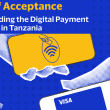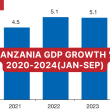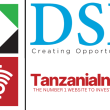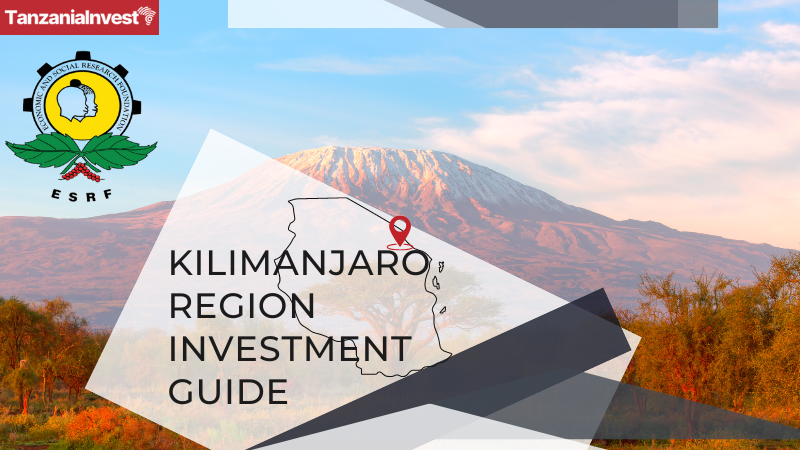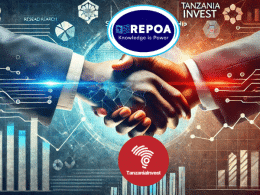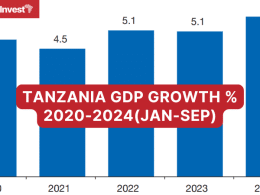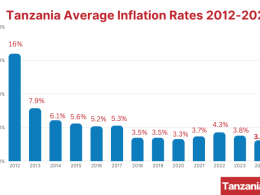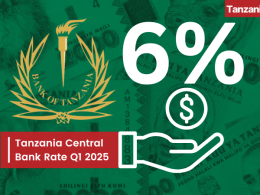The Economic and Social Research Foundation (ESRF) has prepared a detailed investment guide for Tanzania’s Kilimanjaro region, highlighting the area’s strategic importance and diverse opportunities for local and foreign investors.
As part of a partnership initiative to reach a wider audience of potential investors, TanzaniaInvest is republishing this guide along with other regional investment guides developed by ESRF.
The Kilimanjaro Region Investment Guide presents a wealth of investment opportunities across various sectors. Key areas include agriculture and agro-processing, tourism, manufacturing, infrastructure, and mining. The guide aims to attract investors to exploit these opportunities, thereby accelerating the economic growth and development of the region.
Table of Contents
- Foreword
- Disclaimer
- Executive Summary
- Part One: Why One Should Invest in Tanzania and Kilimanjaro Region
- Part Two: Socio-Economic Profile of The Kilimanjaro Region
- Part Three: Potential Investment Areas
- Part Four: Facilitation, Processes, Requirements, and Incentives
- Part Five: Key Contacts in Kilimanjaro Region
Foreword
This Investment guide is meant to implement the development pathway of the region as instructed by the Kilimanjaro Regional Development and Local Government Authorities (LGAs) Development Plans.
It includes information to prospective investors: local and foreign firms as well as individuals and groups with interests to invest in the region. It aims to attract them to exploit available investment opportunities in the region so as to speed up the development growth of the regional economy through viable investments.
Disclaimer
This guidebook was published to assist potential investors in getting essential information regarding investment opportunities in the Kilimanjaro region. The guidebook does not provide exhaustive information or detailed practical assistance on how to establish businesses. The information contained in this guidebook is derived from consultations with regional and district government officials, and public and private sector agencies. None of the information provided in this guidebook can be used for legal redress or any dispute resolution whatsoever.
Executive Summary
Kilimanjaro, located in the northeastern part of Tanzania, is renowned for its iconic Mount Kilimanjaro, the highest peak in Africa. The region borders Kenya to the north, Arusha to the west, Tanga to the southeast, and Manyara to the southwest. It encompasses six districts and seven local government authorities, including Moshi Municipality.
The investment opportunities are in various socio-economic sectors, including industries, agriculture, tourism, health, infrastructure, and education. The region offers a strategic location, a skilled workforce, and a business-friendly environment, making it an attractive destination for investors.
Part One: Why One Should Invest in Tanzania and Kilimanjaro Region
1.1 Investment Environment in Tanzania
The Government of Tanzania has taken a positive approach towards local and international investments, approving Foreign Direct Investments (FDIs) and showing considerable success in attracting them. The laws and regulations permit foreign investments and participation under agreed conditions. The government recognizes the important role of the local private sector in industrialization.
1.2 Reasons for Investing in Tanzania
Tanzania offers a safe, peaceful, and strategically located environment with business-friendly macroeconomic stability, low inflation rates, and a simplified bureaucracy. It is a member of the East African Community and SADC, providing access to large markets. The country offers a well-balanced package of incentives to investors and is emerging as a gateway for trade into eastern, southern, and central Africa.
1.3 Reasons for Investing in Kilimanjaro
Kilimanjaro region offers an advantageous geographic location, a skilled workforce, and a business-friendly investment climate. The region is strategically located, serving as a gateway to neighboring East African countries and is close to Arusha, the headquarters of the East African Community. It has a skilled labor force and a strong entrepreneurial culture. The region provides administrative support, good road networks, and access to electricity and water services.
Part Two: Socio-Economic Profile of The Kilimanjaro Region
2.1 Introduction
Kilimanjaro region is located in the northeastern part of Mainland Tanzania, south of the Equator. It borders Kenya to the northeast, the Tanga region to the southeast, the Arusha region to the west, and the Manyara region to the southwest. The region has an area of 13,209 square kilometers and a population of approximately 1.8 million people.
2.2 Agro-ecological Zones
The region is divided into three agroecological zones: the Coffee Zone, the Wheat Zone, the Mixed Crop Zone (The Lower Zone), and the Forestry Zone.
2.2.1 The Coffee Zone
The Coffee Zone is found at higher and middle altitudes of the region and is intensely cultivated with coffee and bananas.
2.2.2 The Wheat Zone
The Wheat Zone is located in the western part of Mount Kilimanjaro and is suitable for wheat, beans, maize, and dairy production.
2.2.3 The Mixed Crop Zone (The Lower Zone)
The Lower Zone accommodates a variety of agricultural activities, including ranching and cultivation of maize, cotton, beans, and paddy.
2.2.4 The Forestry Zone
The Forestry Zone accounts for 388,500 hectares of forest in the Kilimanjaro region.
2.3 Socio-economic Context
Kilimanjaro region is ranked higher than many parts of the country in terms of socio-economic indicators. The region’s GDP was TZS 4,126,036 million in 2015, and its GDP per capita was TZS 2,387,031. The region scored an HDI of 0.75, leading the remaining 25 regions of Tanzania Mainland.
Part Three: Potential Investment Areas
3.1 Introduction
The region has identified seven investment opportunities: industries, animal husbandry, agriculture, tourism, health, infrastructure, and education/skills development. Investment in these areas will increase employment and enable the region to increase its GDP and per capita incomes.
3.2 Regional and District Investment Opportunities
3.2.1 Regional Investment Priorities
- Agriculture: Construction of an international cereal market.
- Agriculture/Livestock: Artificial insemination for the cattle industry.
- Industry: Building a printing press, secondary processing of vegetables and fruits, meat processing, milk processing into various dairy products, and packaging materials for both primary and secondary processing industries.
- Tourism: Building Kilimanjaro International Tourism Centre.
3.2.2 Districts Investment Priorities
Each district in the Kilimanjaro region has specific investment priorities, including value addition in primary processing of horticultural products, vocational training on skill development, construction of modern slaughterhouses, cement industry, construction of modern markets and shopping malls, irrigation infrastructure, and contract farming.
3.3 Investment Analysis
3.3.1 Agriculture
Agriculture is the main economic activity in the region, contributing about 60 percent to the region’s GDP and over 75 percent of employment to the rural population. The region has opportunities for irrigation farming, livestock, and feed resources.
3.3.2 Horticulture
The region has favorable geographical and climatic conditions for horticulture, ensuring a year-round growing season for flowers, cuttings, vegetables, and horticultural seeds.
3.3.3 Industries/Manufacturing
The region offers a number of produces like coffee, wheat, maize, ginger, sugarcane, and forest plantations, providing plenty of raw materials for manufacturing industries. Investment in agro-based and service-oriented small-scale industries is encouraged.
3.3.4 Mining
The region is endowed with minerals like gypsum, limestone, bauxite, copper, aquamarine, red garnet, pozzolana, and ceramics. The region invites investors for joint ventures to develop and expand production in this sector.
3.3.5 Tourism
The region has abundant tourist attractions, including Mount Kilimanjaro, Mount Shengena, Kilimanjaro National Park, hot springs, and cultural tourism. Investment opportunities include building tourist hotels, campsites, and other facilities.
3.3.6 Economic Infrastructure
The region has a reliable electric power supply, good air service, and opportunities for developing wind energy, biogas plants, solid waste management, and solar energy.
3.3.7 Commercial
Investment opportunities include constructing modern markets and shopping malls, bus stations, stadiums, and recreation centers.
3.3.8 Education
Investment opportunities in education include vocational training on skills development in various fields, particularly in primary value addition of horticultural and honey products.
3.4 The Guide’s Target Groups
The guide targets investors, business owners, stakeholders, government ministries, agencies, local government authorities, academia, research institutions, development partners, and other private sector entities.
Part Four: Facilitation, Processes, Requirements, and Incentives
4.1 Facilitation
The Kilimanjaro region and central government have set favorable conditions to entice and facilitate investment. Key investment policies, laws, strategies, plans, and programs are in place to promote investment in the region.
4.1.1 Policies, Legal, Institutional and Regulatory Considerations
Key policies include the National Investment Promotion Policy, National Agricultural Policy, National Livestock Policy, and others. Key laws include the Tanzania Investment Act, Tanzania Revenue Authority Act, Land Act, and others.
4.1.2 Strategies, Plans, and Programs
Key strategies and plans include the Five Year Development Plan (FYDP II), Agricultural Sector Development Strategy and Program (ASDP II), Livestock Sector Development Program, and others.
4.2 Processes and Requirements
The main processes for prospective investors include registration, obtaining permits, and complying with tax requirements.
4.2.1 Lead Institution
Tanzania Investment Centre (TIC) is the lead institution for promoting, coordinating, and facilitating investment in Tanzania.
4.2.2 Registration
Registration of an investment can be undertaken at the local BRELA and District, Regional, or National Tanzania Investment Centre.
4.2.3 Taxes
The taxes involved in investment projects include corporate tax, personal income taxes, withholding taxes, and Value Added Tax (VAT).
4.3 Incentives
Investors registered under the Tanzania Investment Centre are accorded tax incentives as per the Income Tax Act, Value Added Tax Act, and other applicable tax laws.
4.3.1 Import Duty and VAT Exemption on Deemed Capital Goods
Import duty exemption is granted to the tune of 75 percent of the import duty payable on the approved deemed capital goods.
4.4 Land for Investment in Tanzania
Land for investment purposes shall be identified, gazetted, and allocated to the Tanzania Investment Centre.
4.5 Participation of the Private Sector
The region plans to stimulate its industrial and economic development base by attracting additional private and public-private partnership investments.
Part Five: Key Contacts in Kilimanjaro Region
Websites for Local Government Authorities in Kilimanjaro Region
Websites for Local Government Authorities in Kilimanjaro Region:
Key Contacts in the Regional and Local Government Authorities in Kilimanjaro Region
- Regional Administrative Secretary (RAS): P.O. Box 3070, Moshi, +255 027 2758248, ras@kilimanjaro.go.tz
- Regional Commissioner’s Office: P.O. Box 3070, Moshi, +255 027 2758248, ras@kilimanjaro.go.tz

